Zhe Tang
EMP: Enhance Memory in Data Pruning
Aug 28, 2024



Abstract:Recently, large language and vision models have shown strong performance, but due to high pre-training and fine-tuning costs, research has shifted towards faster training via dataset pruning. Previous methods used sample loss as an evaluation criterion, aiming to select the most "difficult" samples for training. However, when the pruning rate increases, the number of times each sample is trained becomes more evenly distributed, which causes many critical or general samples to not be effectively fitted. We refer to this as Low-Frequency Learning (LFL). In other words, LFL prevents the model from remembering most samples. In our work, we decompose the scoring function of LFL, provide a theoretical explanation for the inefficiency of LFL, and propose adding a memory term to the scoring function to enhance the model's memory capability, along with an approximation of this memory term. Similarly, we explore memory in Self-Supervised Learning (SSL), marking the first discussion on SSL memory. Using contrastive learning, we derive the memory term both theoretically and experimentally. Finally, we propose Enhance Memory Pruning (EMP), which addresses the issue of insufficient memory under high pruning rates by enhancing the model's memory of data, thereby improving its performance. We evaluated the performance of EMP in tasks such as image classification, natural language understanding, and model pre-training. The results show that EMP can improve model performance under extreme pruning rates. For example, in the CIFAR100-ResNet50 pre-training task, with 70\% pruning, EMP outperforms current methods by 2.2\%.
Hierarchical Stage-Wise Training of Linked Deep Neural Networks for Multi-Building and Multi-Floor Indoor Localization Based on Wi-Fi RSSI Fingerprinting
Jul 18, 2024Abstract:In this paper, we present a new solution to the problem of large-scale multi-building and multi-floor indoor localization based on linked neural networks, where each neural network is dedicated to a sub-problem and trained under a hierarchical stage-wise training framework. When the measured data from sensors have a hierarchical representation as in multi-building and multi-floor indoor localization, it is important to exploit the hierarchical nature in data processing to provide a scalable solution. In this regard, the hierarchical stage-wise training framework extends the original stage-wise training framework to the case of multiple linked networks by training a lower-hierarchy network based on the prior knowledge gained from the training of higher-hierarchy networks. The experimental results with the publicly-available UJIIndoorLoc multi-building and multi-floor Wi-Fi RSSI fingerprint database demonstrate that the linked neural networks trained under the proposed hierarchical stage-wise training framework can achieve a three-dimensional localization error of 8.19 m, which, to the best of the authors' knowledge, is the most accurate result ever obtained for neural network-based models trained and evaluated with the full datasets of the UJIIndoorLoc database, and that, when applied to a model based on hierarchical convolutional neural networks, the proposed training framework can also significantly reduce the three-dimensional localization error from 11.78 m to 8.71 m.
Mean Teacher based SSL Framework for Indoor Localization Using Wi-Fi RSSI Fingerprinting
Jul 18, 2024Abstract:Wi-Fi fingerprinting is widely applied for indoor localization due to the widespread availability of Wi-Fi devices. However, traditional methods are not ideal for multi-building and multi-floor environments due to the scalability issues. Therefore, more and more researchers have employed deep learning techniques to enable scalable indoor localization. This paper introduces a novel semi-supervised learning framework for neural networks based on wireless access point selection, noise injection, and Mean Teacher model, which leverages unlabeled fingerprints to enhance localization performance. The proposed framework can manage hybrid in/outsourcing and voluntarily contributed databases and continually expand the fingerprint database with newly submitted unlabeled fingerprints during service. The viability of the proposed framework was examined using two established deep-learning models with the UJIIndoorLoc database. The experimental results suggest that the proposed framework significantly improves localization performance compared to the supervised learning-based approach in terms of floor-level coordinate estimation using EvAAL metric. It shows enhancements up to 10.99% and 8.98% in the former scenario and 4.25% and 9.35% in the latter, respectively with additional studies highlight the importance of the essential components of the proposed framework.
LNPT: Label-free Network Pruning and Training
Mar 20, 2024



Abstract:Pruning before training enables the deployment of neural networks on smart devices. By retaining weights conducive to generalization, pruned networks can be accommodated on resource-constrained smart devices. It is commonly held that the distance on weight norms between the initialized and the fully-trained networks correlates with generalization performance. However, as we have uncovered, inconsistency between this metric and generalization during training processes, which poses an obstacle to determine the pruned structures on smart devices in advance. In this paper, we introduce the concept of the learning gap, emphasizing its accurate correlation with generalization. Experiments show that the learning gap, in the form of feature maps from the penultimate layer of networks, aligns with variations of generalization performance. We propose a novel learning framework, LNPT, which enables mature networks on the cloud to provide online guidance for network pruning and learning on smart devices with unlabeled data. Our results demonstrate the superiority of this approach over supervised training.
SEVEN: Pruning Transformer Model by Reserving Sentinels
Mar 19, 2024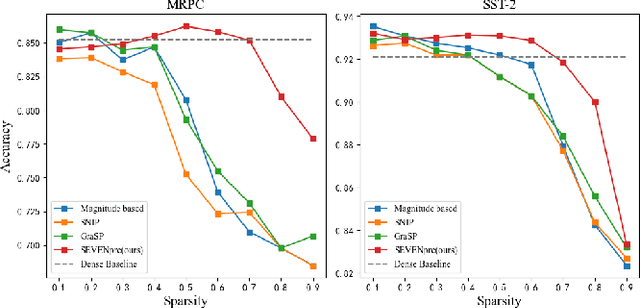
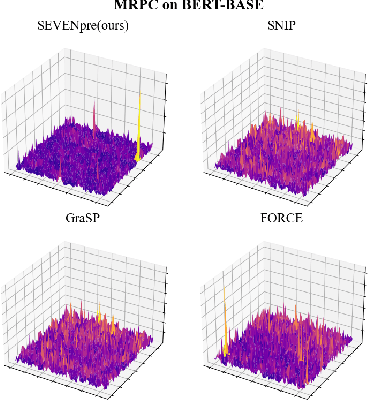
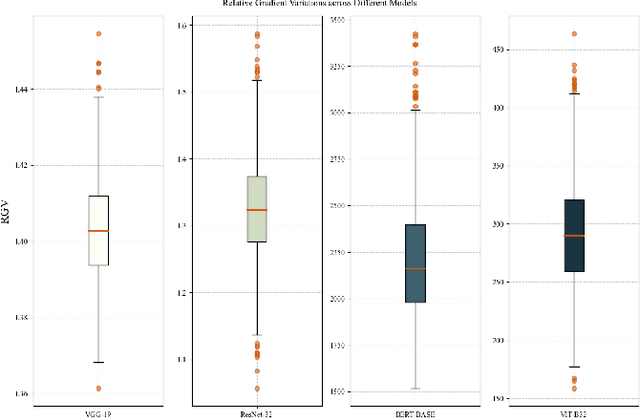
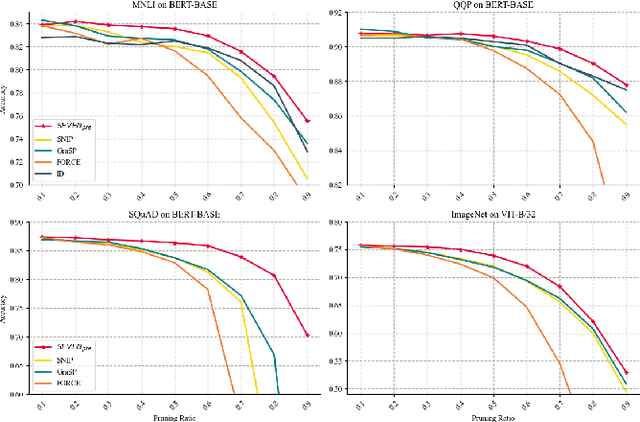
Abstract:Large-scale Transformer models (TM) have demonstrated outstanding performance across various tasks. However, their considerable parameter size restricts their applicability, particularly on mobile devices. Due to the dynamic and intricate nature of gradients on TM compared to Convolutional Neural Networks, commonly used pruning methods tend to retain weights with larger gradient noise. This results in pruned models that are sensitive to sparsity and datasets, exhibiting suboptimal performance. Symbolic Descent (SD) is a general approach for training and fine-tuning TM. In this paper, we attempt to describe the noisy batch gradient sequences on TM through the cumulative process of SD. We utilize this design to dynamically assess the importance scores of weights.SEVEN is introduced by us, which particularly favors weights with consistently high sensitivity, i.e., weights with small gradient noise. These weights are tended to be preserved by SEVEN. Extensive experiments on various TM in natural language, question-answering, and image classification domains are conducted to validate the effectiveness of SEVEN. The results demonstrate significant improvements of SEVEN in multiple pruning scenarios and across different sparsity levels. Additionally, SEVEN exhibits robust performance under various fine-tuning strategies. The code is publicly available at https://github.com/xiaojinying/SEVEN.
Static vs. Dynamic Databases for Indoor Localization based on Wi-Fi Fingerprinting: A Discussion from a Data Perspective
Feb 20, 2024Abstract:Wi-Fi fingerprinting has emerged as the most popular approach to indoor localization. The use of ML algorithms has greatly improved the localization performance of Wi-Fi fingerprinting, but its success depends on the availability of fingerprint databases composed of a large number of RSSIs, the MAC addresses of access points, and the other measurement information. However, most fingerprint databases do not reflect well the time varying nature of electromagnetic interferences in complicated modern indoor environment. This could result in significant changes in statistical characteristics of training/validation and testing datasets, which are often constructed at different times, and even the characteristics of the testing datasets could be different from those of the data submitted by users during the operation of localization systems after their deployment. In this paper, we consider the implications of time-varying Wi-Fi fingerprints on indoor localization from a data-centric point of view and discuss the differences between static and dynamic databases. As a case study, we have constructed a dynamic database covering three floors of the IR building of XJTLU based on RSSI measurements, over 44 days, and investigated the differences between static and dynamic databases in terms of statistical characteristics and localization performance. The analyses based on variance calculations and Isolation Forest show the temporal shifts in RSSIs, which result in a noticeable trend of the increase in the localization error of a Gaussian process regression model with the maximum error of 6.65 m after 14 days of training without model adjustments. The results of the case study with the XJTLU dynamic database clearly demonstrate the limitations of static databases and the importance of the creation and adoption of dynamic databases for future indoor localization research and real-world deployment.
On the Multidimensional Augmentation of Fingerprint Data for Indoor Localization in A Large-Scale Building Complex Based on Multi-Output Gaussian Process
Nov 19, 2022Abstract:Wi-Fi fingerprinting becomes a dominant solution for large-scale indoor localization due to its major advantage of not requiring new infrastructure and dedicated devices. The number and the distribution of Reference Points (RPs) for the measurement of localization fingerprints like RSSI during the offline phase, however, greatly affects the localization accuracy; for instance, the UJIIndoorLoc is known to have the issue of uneven spatial distribution of RPs over buildings and floors. Data augmentation has been proposed as a feasible solution to not only improve the smaller number and the uneven distribution of RPs in the existing fingerprint databases but also reduce the labor and time costs of constructing new fingerprint databases. In this paper, we propose the multidimensional augmentation of fingerprint data for indoor localization in a large-scale building complex based on Multi-Output Gaussian Process (MOGP) and systematically investigate the impact of augmentation ratio as well as MOGP kernel functions and models with their hyperparameters on the performance of indoor localization using the UJIIndoorLoc database and the state-of-the-art neural network indoor localization model based on a hierarchical RNN. The investigation based on experimental results suggests that we can generate synthetic RSSI fingerprint data up to ten times the original data -- i.e., the augmentation ratio of 10 -- through the proposed multidimensional MOGP-based data augmentation without significantly affecting the indoor localization performance compared to that of the original data alone, which extends the spatial coverage of the combined RPs and thereby could improve the localization performance at the locations that are not part of the test dataset.
Multi-Output Gaussian Process-Based Data Augmentation for Multi-Building and Multi-Floor Indoor Localization
Feb 04, 2022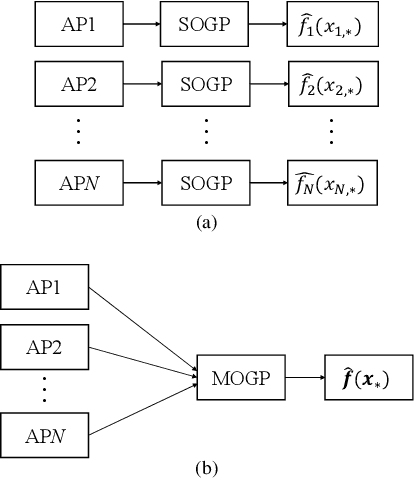
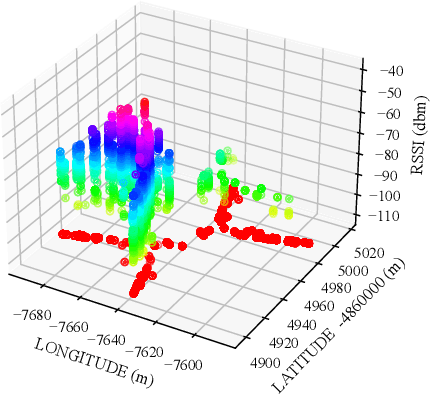
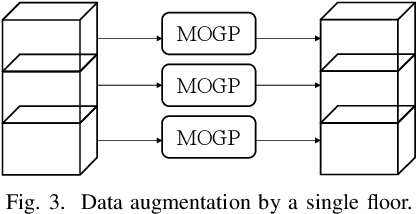
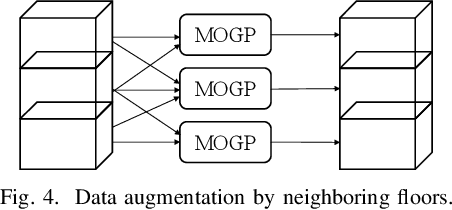
Abstract:Location fingerprinting based on RSSI becomes a mainstream indoor localization technique due to its advantage of not requiring the installation of new infrastructure and the modification of existing devices, especially given the prevalence of Wi-Fi-enabled devices and the ubiquitous Wi-Fi access in modern buildings. The use of AI/ML technologies like DNNs makes location fingerprinting more accurate and reliable, especially for large-scale multi-building and multi-floor indoor localization. The application of DNNs for indoor localization, however, depends on a large amount of preprocessed and deliberately-labeled data for their training. Considering the difficulty of the data collection in an indoor environment, especially under the current epidemic situation of COVID-19, we investigate three different methods of RSSI data augmentation based on Multi-Output Gaussian Process (MOGP), i.e., by a single floor, by neighboring floors, and by a single building; unlike Single-Output Gaussian Process (SOGP), MOGP can take into account the correlation among RSSI observations from multiple Access Points (APs) deployed closely to each other (e.g., APs on the same floor of a building) by collectively handling them. The feasibility of the MOGP-based RSSI data augmentation is demonstrated through experiments based on the state-of-the-art RNN indoor localization model and the UJIIndoorLoc, i.e., the most popular publicly-available multi-building and multi-floor indoor localization database, where the RNN model trained with the UJIIndoorLoc database augmented by using the whole RSSI data of a building in fitting an MOGP model (i.e., by a single building) outperforms the other two augmentation methods as well as the RNN model trained with the original UJIIndoorLoc database, resulting in the mean three-dimensional positioning error of 8.42 m.
A differential evolution-based optimization tool for interplanetary transfer trajectory design
Nov 17, 2020



Abstract:The extremely sensitive and highly nonlinear search space of interplanetary transfer trajectory design bring about big challenges on global optimization. As a representative, the current known best solution of the global trajectory optimization problem (GTOP) designed by the European space agency (ESA) is very hard to be found. To deal with this difficulty, a powerful differential evolution-based optimization tool named COoperative Differential Evolution (CODE) is proposed in this paper. CODE employs a two-stage evolutionary process, which concentrates on learning global structure in the earlier process, and tends to self-adaptively learn the structures of different local spaces. Besides, considering the spatial distribution of global optimum on different problems and the gradient information on different variables, a multiple boundary check technique has been employed. Also, Covariance Matrix Adaptation Evolutionary Strategies (CMA-ES) is used as a local optimizer. The previous studies have shown that a specific swarm intelligent optimization algorithm usually can solve only one or two GTOP problems. However, the experimental test results show that CODE can find the current known best solutions of Cassini1 and Sagas directly, and the cooperation with CMA-ES can solve Cassini2, GTOC1, Messenger (reduced) and Rosetta. For the most complicated Messenger (full) problem, even though CODE cannot find the current known best solution, the found best solution with objective function equaling to 3.38 km/s is still a level that other swarm intelligent algorithms cannot easily reach.
XJTLUIndoorLoc: A New Fingerprinting Database for Indoor Localization and Trajectory Estimation Based on Wi-Fi RSS and Geomagnetic Field
Oct 17, 2018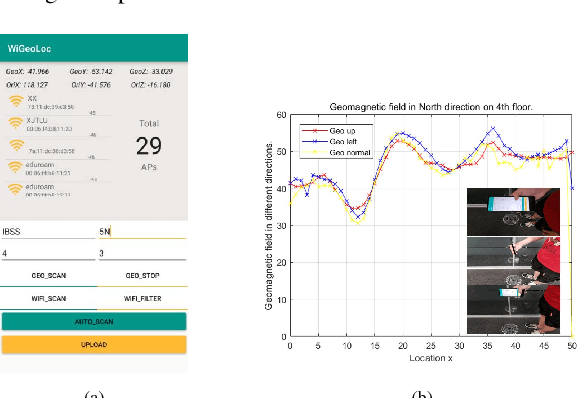
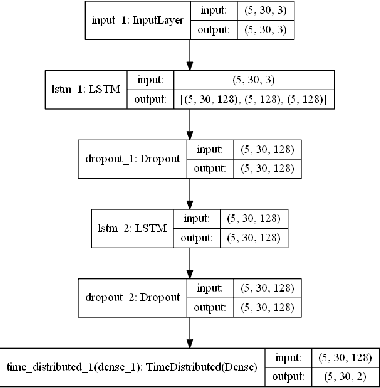
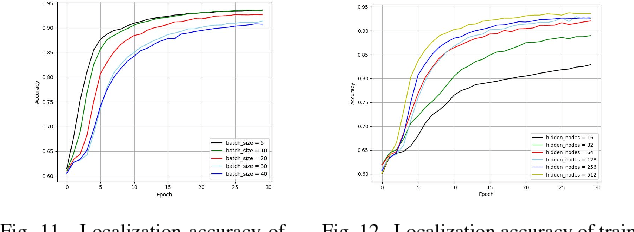
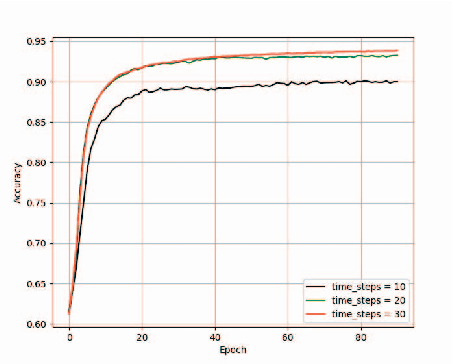
Abstract:In this paper, we present a new location fingerprinting database comprised of Wi-Fi received signal strength (RSS) and geomagnetic field intensity measured with multiple devices at a multi-floor building in Xi'an Jiatong-Liverpool University, Suzhou, China. We also provide preliminary results of localization and trajectory estimation based on convolutional neural network (CNN) and long short-term memory (LSTM) network with this database. For localization, we map RSS data for a reference point to an image-like, two-dimensional array and then apply CNN which is popular in image and video analysis and recognition. For trajectory estimation, we use a modified random way point model to efficiently generate continuous step traces imitating human walking and train a stacked two-layer LSTM network with the generated data to remember the changing pattern of geomagnetic field intensity against (x,y) coordinates. Experimental results demonstrate the usefulness of our new database and the feasibility of the CNN and LSTM-based localization and trajectory estimation with the database.
 Add to Chrome
Add to Chrome Add to Firefox
Add to Firefox Add to Edge
Add to Edge